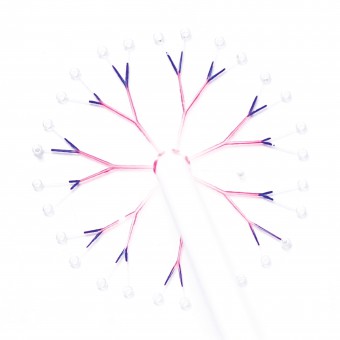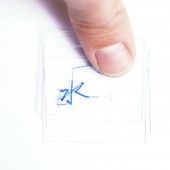Venous Materials Interactive Sensors and Display by Hila Mor |
Home > Winners > #108491 |
 |
|
||||
| DESIGN DETAILS | |||||
| DESIGN NAME: Venous Materials PRIMARY FUNCTION: Interactive Sensors and Display INSPIRATION: This project is inspired by venous structures that are ubiquitous throughout nature and inside the human body. By changing colors, veins can inform us of internal and external physical conditions. For example, veins in leaves transmit pigments that drive color change, which informs us of the internal condition of the leaf and which season it is. UNIQUE PROPERTIES / PROJECT DESCRIPTION: Venous Materials technology developed through research on current Microfluidics, that is specifically designed for human interaction and user experience. A specilized computational tool was developed for the design process and to simulate and visualize of the color change and display of the flow within the material, according to the user input. Production process involves laser engraving and manual lab processes. Materials used are PDMS silicone and ecoline ink. OPERATION / FLOW / INTERACTION: The displayed flow pattern and color change of the fluidic channels within Venous Materials inform the users of the motion and physical force that is applied on the material. The users can interact with Venous Materials by deforming or applying pressure on the material, which drives the fluid flow within the internal channels to visualize the dynamic responsive display. Therefore, Venous Materials simultaneously functions as a sensor and display of tangible information. PROJECT DURATION AND LOCATION: The project started June 2019 and finished April 2020 in Cambridge, MA, at the MIT Media Lab, Tangible Media group |
PRODUCTION / REALIZATION TECHNOLOGY: Through utilizing latest research with Microfluidics technology, Venous Materials was developed while focus on human interaction and UX design. To realize the design and production process, a specialized computational design and simulation tool was developed. This tool allows to simulate and visualize of the color change and display of the flow within the material, according to the user physical input. Production process involves laser engraving and lab processes. Materials used are PDMS silicone and ecoline ink. SPECIFICATIONS / TECHNICAL PROPERTIES: Venous Materials prototypes size range between 5cmX5cm and 15x15cm. These samples can be assembled together to form a larger sheet. TAGS: Interaction Design, Material research, Dynamic Graphics, Microfluidics, Computational Aided Design, Sensors and Displays, Venous Structures RESEARCH ABSTRACT: This work present design and fabrication methods for interactive fluidic mechanisms that respond to deformation by mechanical inputs from the user. The Venous design tool provides designers with a simple way to create and validate designs of fluidic structures. It allows users to design the geometry, and simulate the flow with intended mechanical force dynamically. This leads to Interactive applications of Venous Materials, to augment human movement and everyday objects. CHALLENGE: While current computer chips and electronics usually require rigid and bulky components that challenges the integration with varied objects or fabrics, Venous Materials is soft and self-contained mechanism that utilizes the motion of daily activities as its energy source. Design of micro-fluid dynamics is not intuitive task, our approach and computational tool allows the design, simulation, and prototyping of fluidic interactive sensors that can be embedded in, or attached to, any object. ADDED DATE: 2020-07-24 13:21:30 TEAM MEMBERS (1) : Hila Mor, Tianyu Yu, Ken Nakagaki, Benjamin Harvey Miller, Yichen Jia, Hiroshi Ishii IMAGE CREDITS: All Photo/video credit to Tangible Media Group, MIT Media Lab |
||||
| Visit the following page to learn more: http://bit.ly/3gj9oul | |||||
| AWARD DETAILS | |
 |
Venous Materials Interactive Sensors and Display by Hila Mor is Winner in Design Quality and Innovation Category, 2020 - 2021.· Read the interview with designer Hila Mor for design Venous Materials here.· Press Members: Login or Register to request an exclusive interview with Hila Mor. · Click here to register inorder to view the profile and other works by Hila Mor. |
| SOCIAL |
| + Add to Likes / Favorites | Send to My Email | Comment | Testimonials | View Press-Release | Press Kit |
Did you like Hila Mor's Design Quality?
You will most likely enjoy other award winning design quality as well.
Click here to view more Award Winning Design Quality.








